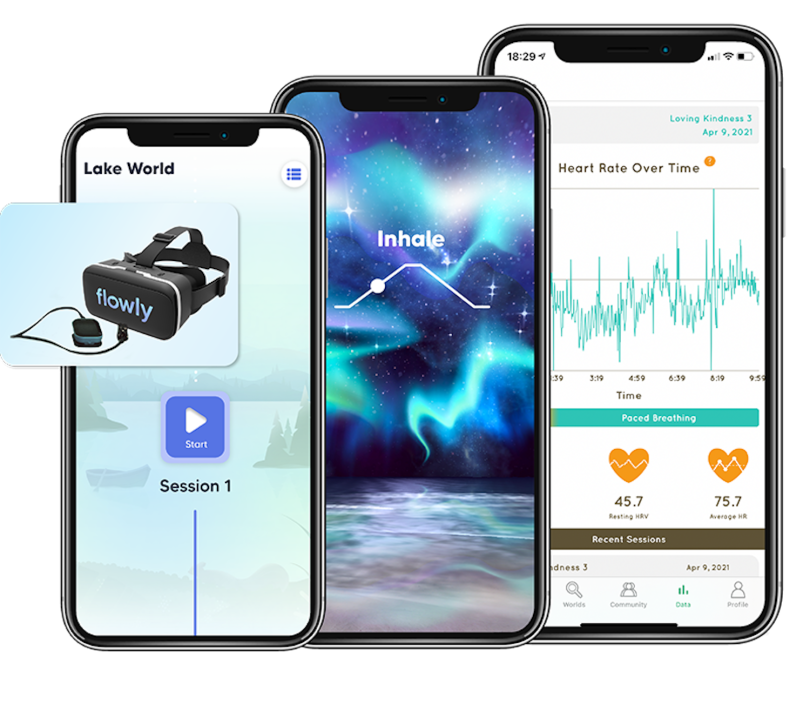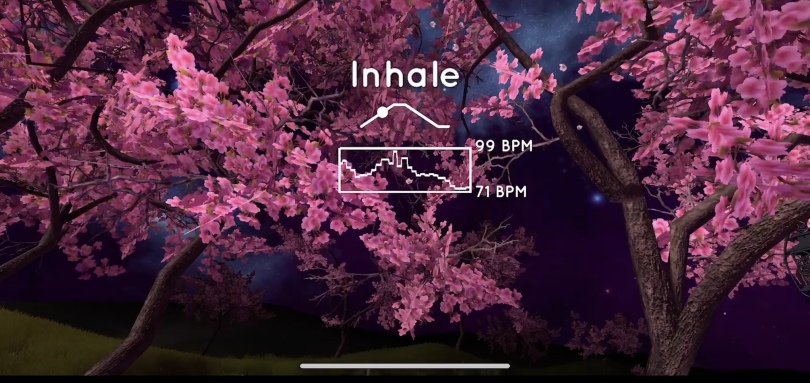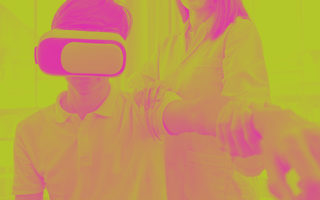Nearly a decade ago, 77 psychology students from the University of Barcelona participated in an intriguing study of a virtual reality intervention to manage pain. Wearing stereoscopic 3D glasses and gazing at animated virtual reality images, the students dipped their hands into an ice water bath kept at 42 degrees Fahrenheit. That’s shockingly cold — it’s the temperature of the Baltic Sea in late winter.
Participants were divided into two test groups and a control group. As images of a surreal virtual reality world created in Autodesk 3D Studio Max 8 flashed across a computer screen, those in the first test group could click on strange cubist forms to change how they behaved — all with their second hand immersed in the cold water. They were told to inform researchers when their hands became uncomfortable and, if the pain became unbearable, they could stop the experiment by saying “end.”
Users in the second group were shown a jagged avatar modeled after words people commonly use to describe their pain — phrases like “sharp,” “burning” and “stabbing.” A loud, high-pitched tone played in the headset, making the experience all the more intolerable.
But those in the second group had a different mode of interaction. They could use the mouse and slider controls to modify the figure, surroundings and music — essentially making the experience more pleasant by rounding the sharp edges of the avatar, inviting in natural scenery and dialing back the cacophonous noise.
The key question researchers investigated was whether the second VR model, a decidedly more interactive one, would have a more pronounced effect on users’ pain tolerance, sensitivity and perceived agency to alleviate their pain. What they found, as reported in a 2014 study published in the journal Cyberpsychology, Behavior and Social Networking, was that both models increased participants’ pain tolerance and sensitivity range. Participants waited longer before reporting that they were in pain and kept their hands immersed in the frigid water longer.
Interestingly, though, those in the second group reported a greater sense of self-efficacy. Being able to manipulate the figure and sound to their liking meant they didn’t feel as helpless to control the pain in their hands.
This story is part of Built In’s “Designer’s Playbook” series, which examines the most important emerging trends and skills for design and UX professionals in 2021.
VR Has Been Used to Treat Pain Since the 1980s
The study, and a pattern of similar findings in peer-reviewed medical journals, has laid the groundwork for Flowly, an app that uses biofeedback and therapeutic VR to help people manage chronic pain and stress.
Flowly was co-founded by CEO Celine Tien, an acclaimed filmmaker and former feature developer at Oriental DreamWorks in Shanghai and DreamWorks in Los Angeles, and Julien Soros, Flowly’s chief technical officer, who earlier in his career developed algorithms to run simulations for the propulsion systems of Hyperloop One, a high-speed transportation system now owned — and being prototype tested in Las Vegas — by Richard Branson’s company under the name Virgin Hyperloop.
The company has ambitious plans. Tien’s parents were medical researchers who ran clinical trials for pancreatic cancer studies and developed an orphan drug designation for a palliative cancer treatment. After writing and directing one of the world’s first VR live-action films, Pippa’s Pan 盼, which was selected for the 2017 Festival de Cannes VR Library Showcase, the Yale graduate wanted to carry on their medical legacy — with VR.
“I realized all this awesome technology that we’re using for entertainment had actually been developed and applied for pain management therapy since the ’80s — for a population I care about,” she said. “Even though biofeedback and even VR have been used for pain management for quite a while now, it’s very inaccessible. We really realized that pain management has to be something that you can do on a daily basis when you really need it.”
“I realized all this awesome technology that we’re using for entertainment had actually been developed and applied for pain management therapy since the 80s — for a population I care about.”
The app and an accompanying VR headset and heart rate monitor, available in the App Store for a $30 monthly subscription fee, are designed to make that possible. Conceptualized by chief creative officer Narae Kim, a visual artist and former theater designer, the interfaces transport users to immersive 3D environments such as Wave World, where, sitting by the sea, they gaze at the blue-green horizon of the aurora borealis, or Cherry Blossom World, where lanterns illuminate a landscape of pink-petaled cherry blossom trees surrounding a lake.
“You enter all these different beautiful worlds, and you’re able to see breathing indicators and hear voiceover guiding the experience. We’re teaching you how to change your perception,” Tien said.

Flow Theory
If all this sounds a bit New Agey, Tien insists it is not. Flowly’s therapeutic approach — overseen by Gail Lucas, a research assistant professor at the University of Southern California’s Viterbi School of Engineering, and a clinical team of doctors, therapists and trauma specialists — is rooted in a growing body of research suggesting the benefits of biofeedback training and VR therapies for managing pain and stress, she told me.
Flowly is currently testing the app’s therapeutic benefits in a controlled clinical trial led by Aman Mahajan, the chair of the department of anesthesiology and perioperative medicine at the University of Pittsburgh Medical Center. Funded by the National Institutes of Health and the National Institute of Drug Abuse, the research team plans to publish a report early next year. In the meantime, Flowly has been collecting survey data from registered users who self-report, on average, a 46 percent reduction in pain after each session.
“That’s really our ambition: to see an actual, tangible increase in somebody’s physical and physiological condition,” Tien said. “Two minutes a day that people don’t actually think about their pain at all.”
But how does VR therapy relieve pain? And why? I posed these questions to Tien, who pointed me to a number of recent studies.
“That’s really our ambition: to see an actual, tangible increase in somebody’s physical and physiological condition.”
Some researchers speculate that VR distracts people from their pain, transporting them to an immersive world that absorbs their attention. Others have studied how VR could alter the neural pathways involved in how people think or be coupled with cognitive behavioral therapy and responsive biofeedback signals to coax patients into a state of relaxation.
Tien believes VR helps users achieve flow — a psychological condition first described by Mihaly Csikszentmihalyi in the book Flow: The Psychology of Optimal Experience as “a state in which people are so involved in an activity that nothing else seems to matter; the experience is so enjoyable that people will continue to do it even at great cost, for the sheer sake of doing it.” It’s what athletes feel when they’re practicing or writers feel when they’re immersed in an engrossing story, she told me.
Neurologically, the flow state appears to be rooted in the activities of the autonomic nervous system, which controls involuntary functions like breathing, heart rate and digestion. The system is divided into two main areas: the sympathetic system and the parasympathetic system. Some scientists believe that, by dialing back the activity of the sympathetic system — the locus of the so-called fight-or-flight response near the thoracic and lumbar regions in the spinal cord — and intensifying the parasympathetic system, the body’s rest and recovery mode, biofeedback training helps improve the nervous system’s response to pain and anxiety.
While the specific biologic processes behind this body-mind relationship are fairly sophisticated, heart rate variability appears to be a key metric. Not only has low heart rate variability been found to be associated with increased pain perception in chronic pain patients, it is also linked to reduced emotional and cognitive self-regulation, panic disorder and post-traumatic stress disorder. If VR and biofeedback can help increase heart rate variability, the scientific literature suggests, they can help counteract these maladies.

As Heart Rate Variability Changes, So Does the VR World
Flowly incorporates this growing body of research into the app’s design. While a user is in VR, the app collects real-time biodata — including respiration rate and heart rate variability — through a smartphone camera sensor or a VR headset that clips to the ear lobe. A hypnotic voice narrates diaphragmatic breathing exercises, encouraging the user to inhale and exhale at regular intervals, while performing tasks like growing and harvesting plants or scrolling a finger across the screen to pace their breathing.
What’s perhaps most interesting about the app is the feedback loop it creates to reinforce effective relaxation techniques. As a person’s pulse and respiration rates change, so do the VR environments. Constellations brighten or fade in the night sky. The glow of lanterns intensifies. Cherry blossom petals fall to the ground. There is a kind of coherence, in other words, between the images on the screen and a user’s physiologic condition.
“So there is no punishment. Even if your performance is not great, the flowers will not die. You will only create more flowers when you feel more relaxed.”
“And we find that it really increases the efficacy for people, both by creating an element of distraction from their existing anxiety and pain through a focus on the biofeedback training and then also giving them an immersive stimuli they can recall outside of VR,” Soros told me.
The app’s gamified features extend beyond the VR experience. Days of consecutive use are recorded under a fire icon in a user’s profile, and coins earned for participating in sessions, called Flokens, can be redeemed for gifts like cleansing masks, audio lessons and iPhone wallpapers.
Biodata is relatively easy to track. Users’ breathing rates and heart rate variability are stored in a data dashboard, and people can view their pain scores before and after a session and chart their day-to-day feelings and medication regimens in an in-app journal. But while gamification is core to the experience, the app steers clear of negative feedback.
“So there is no punishment,” Kim said. “Even if your performance is not great, the flowers will not die. You will only create more flowers when you feel more relaxed. We want to make these worlds a safe space for everyone, places that are very welcoming for them where there is no danger.”
Pain — A Culturally and Geographically Specific Phenomenon
While the app’s design is grounded in clinical studies, the company’s own research — from virtual town halls, user pain scale surveys and A/B testing — has led to intriguing findings. For instance, water scenery and horse imagery elicit almost universally positive reactions among U.S. populations. Less surprising: Cool tones such as blue and green appear to be more effective for promoting relaxation and managing pain than hotter colors such as red and orange.
Still, pain is a subjective, bio-psychosocial experience that appears to be culturally and geographically specific.
“If you grew up in a more urban setting, actually being around a lake or an ocean does not necessarily invoke relaxation and engage your parasympathetic system,” Tien said. “So there’s a lot of socio-economic and cultural considerations to be made. An environment that is relaxing for someone who grew up in suburban America is not necessarily the same as a relaxing environment for a Caribbean community.”
Suggestions from a diverse, online community forum help Kim infuse culturally specific nuances into the mockups she creates. After integrating these ideas into her worlds, she collaborates with writers and a clinical team of therapists and trauma specialists to incorporate a therapeutic narrative. These voiceovers feel a bit like guided meditations: In soft, dulcet tones, a narrator might explain why biodata is being collected, relay scientific research or nudge a distracted user to return to their breathing.
“An environment that is relaxing for someone who grew up in suburban America is not necessarily the same as a relaxing environment for a Caribbean community.”
After the audio is finalized, the design package gets handed off to Soros, who brings Kim’s visual ideas to life by building the VR scenes from stock components and hardcoding reward mechanics into the design.
“We’ve developed a lot of prefab assets that we can drag and drop into the scene, and it makes development really easy,” he said. “And then for each world, there’s just a little bit of customization that we need to do for the specific reward mechanisms. Is the sky changing colors as your heart rate variability changes? Are particles getting bigger or smaller? All these different things are customized for each world.”
A Possible Alternative or Supplement to Opioid Treatment?
In addition to serving its consumer base — dominated by a core group of women aged 35 to 45 who report chronic pain, anxiety, autoimmune conditions and muscle disorders such as fibromyalgia — Flowly’s app and therapeutic approach may provide a supplementary treatment option for clinical patients.
An exploratory study of a similar biofeedback intervention for 14 veterans at the William Jennings Bryan Dorn VA Medical Center in Columbia, South Carolina, found a “marked, significant reduction” in patient’s pain ratings, perceived stress, negative emotions and physical limitations. The authors of the study, published in the journal Global Advances in Health and Medicine, noted that alternative treatments for chronic pain are urgently needed, as standard protocols are “heavily dependent on the use of opioids and opioid receptor binding compounds.”
Though the pilot study needs to be further validated in larger, randomized trials, it suggests heart rate variability coherence biofeedback “is both feasible and effective in increasing cardiac coherence and reducing perceived pain, stress, negative emotions, and physical activity limitations in veterans suffering from chronic physical pain due to injuries.”
Meanwhile, the app is experiencing strong growth among consumers. Though Tien declined to share the number of monthly active users, she told me Flowly is growing its user subscriptions by 20 percent month-over-month. Many users seem pleased by what they’re finding. On the App Store, where the app has a 4.5 star rating, several users claim Flowly has dramatically reduced their pain and anxiety.
“If you’re like me, you’ve tried everything to control the overwhelming anxiety of daily living. I have been an avid meditator and found this to be much more effective during times when I was actively having a panic attack and also in preventing them.”
One user said this: “If you’re like me, you’ve tried everything (especially during the pandemic) to control the overwhelming anxiety of daily living. I have been an avid meditator and found this to be much more effective during times when I was actively having a panic attack and also in preventing them.”
“Because the worlds have things like trees, water and ASMR sounds to match,” the user continued, “I am getting better at being able to recall the way I felt in these VR worlds in the natural world when I am at work. In essence, it’s retraining my brain to escape these states of panic.”
Another wrote: “I’m 37. I’ve been medically disabled since 2017 and living with chronic nerve pain due to a spinal cord crush injury. Additionally, I have generalized anxiety and C-PTSD. [Flowly] can take my pain down several levels because it helps me relax and let go of the tension that’s been building.”
A few reviewers have complained that the app is expensive, including one user who wrote, “the issue is that it’s too costly compared to other options on the market, even if it’s probably better than competitors. So many of us that suffer from anxiety and stress feel this way, in part, because we are financially oppressed.”
Another question is whether people need VR for pain relief at all. Is it substantially different, or better, than taking a walk outside or meditating? These are questions Tien often hears, and her response is generally the same: It’s not an either-or scenario. Virtual reality and biofeedback are not meant to replace these other methods of pain and anxiety relief, but to augment them or provide an accessible alternative for those who have trouble meditating.
Flowly’s physiologic approach to pain management is also fundamentally different than other therapeutic models, according to Tien.
“One thing is the people we are serving are people that have chronic pain and deep anxiety. Telling them to close their eyes and focus on their body is hard, because that’s where their pain is,” she said. “The second thing is that meditation and talk therapy are top-down approaches, whereas biofeedback technology is a bottom-up approach. We teach you how to control your body first, and that affects your mind.”
While the results of the University of Pittsburgh Medical Center clinical trial evaluating strict protocols for reduction of pain and opioid usage are yet to come, Tien is hopeful for what lies ahead, both for the app’s clinical potential and the long-term well-being of the users who have come to rely on it.
“Our North Star metric is the [user] survey data and physiologic data. [We want to help] people improve their cardiovascular health and relaxation and pain scores,” Tien said.




